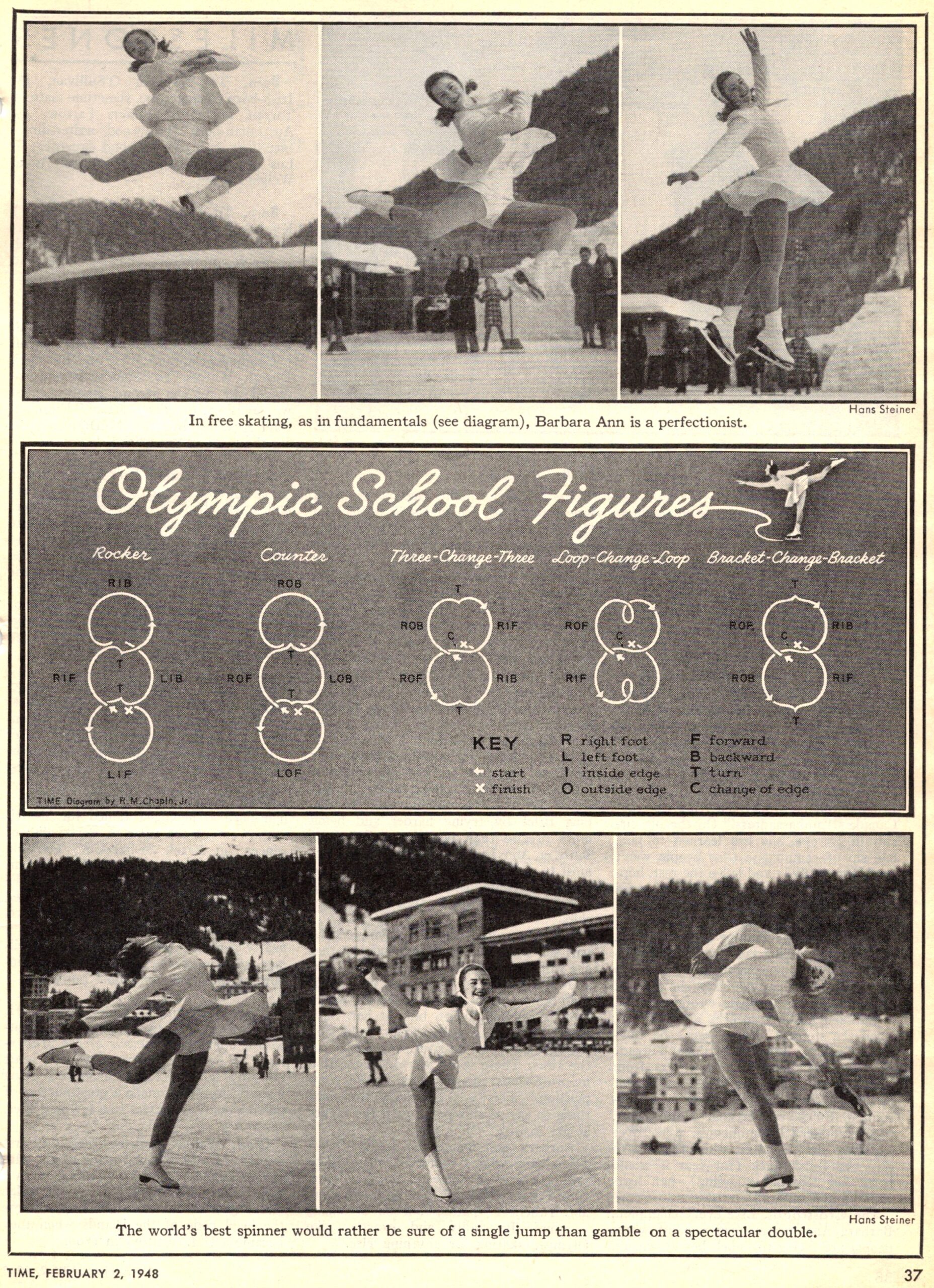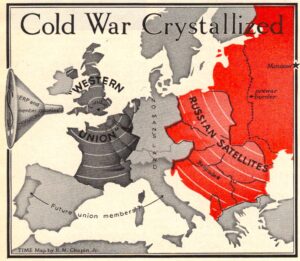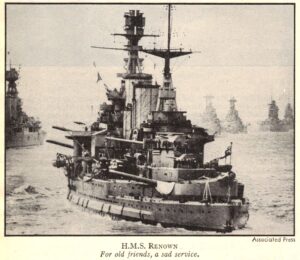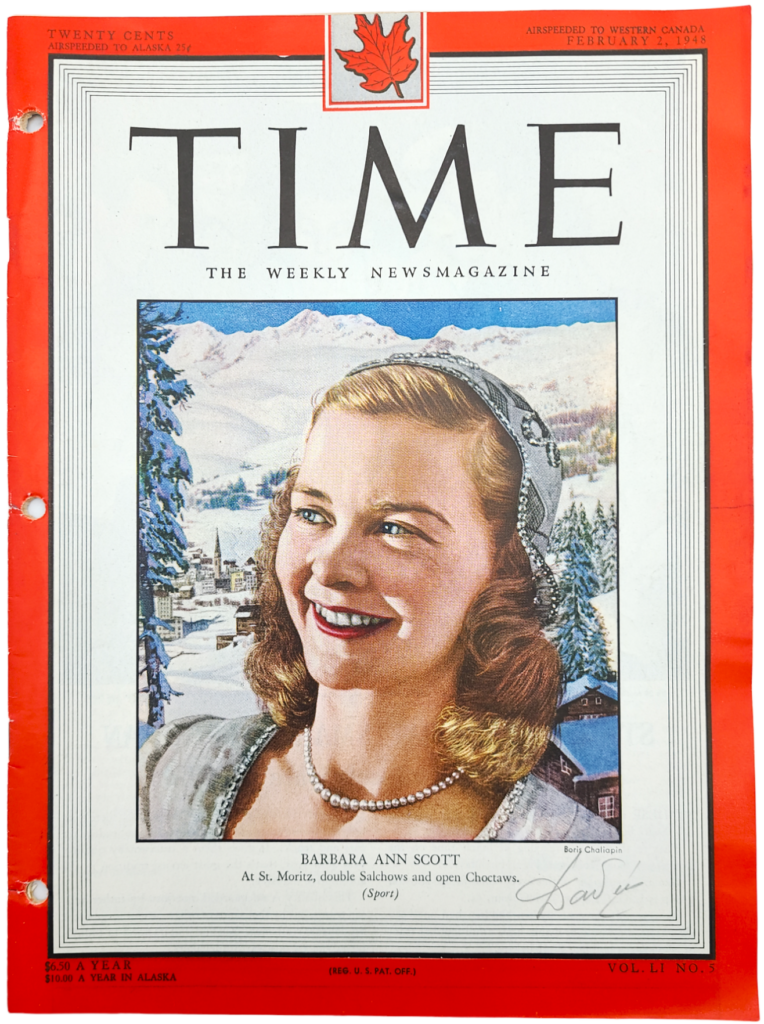Our vintage TIME magazine this week is from February 2, 1948 and features Canada’s figure skating “Ice Queen” Barbara Ann Scott on the cover. This was a time when the world was still trying to recover from World War II, positive stories like the winter olympics and medical breakthroughs brought hope to people.
Barbara Ann Scott - Canada's Sweetheart
 In 1948 the fifth ever winter Olympic games were held in the small resort town of St. Moritz (pop. 2,500). Thirty-one nations participated in a total of nineteen different sporting events. Two events that would be seen by more people than any other were the hockey games and figure skating. Guests were able to watch these two events take place on an outdoor skating surface. Many could view the rink from the comfort of their hotel balconies. It must have been quite a sight when the pairs event took place in a heavy snowstorm.
In 1948 the fifth ever winter Olympic games were held in the small resort town of St. Moritz (pop. 2,500). Thirty-one nations participated in a total of nineteen different sporting events. Two events that would be seen by more people than any other were the hockey games and figure skating. Guests were able to watch these two events take place on an outdoor skating surface. Many could view the rink from the comfort of their hotel balconies. It must have been quite a sight when the pairs event took place in a heavy snowstorm.
There was fear that the 1948 winter Olympics could be the final year for the games. Some “iron cur tain” countries put immense pressure on their athletes to succeed. In fact, it may have actually been a life and death situation for some. Many were understandably nervous about going home without winning.
Despite the weather and the uncertainty about the future of the games, there was one shining star that everyone wanted to see. This star was “Canada’s Sweetheart” and reigning women’s figure-skating champion of the world, 19-year old Barbara Ann Scott.
This young lady’s fame had spread from Ottawa around the world. This TIME article notes that in Prague, newspapers printed her photograph 17 times in 3 days. By comparison Rita Hayworth was only pictured 8 times.
Barbara Ann Scott was an outstanding star at the time. One European judge said “Scott shows up the others when she merely skates on one foot in a straight line.” Barbara Ann didn’t jump higher or skate more daringly than her rivals, she just did it all better. She seemed to float on ice turning effortlessly and unexpectedly then gained momentum without seeming to push. Barbara Ann always seemed to enjoy herself which naturally translated into people enjoying her.
Barbara Ann’s success came through an incredible amount of hard work and dedication.
- 8-years old – Performed as the Spirit of the New Year in the Minto Follies. The Ottawa Journal called her “the darling of the show.”
- 9-years old – she stopped attending school to focus on skating. Her education at the time consisted of 2 ½ hours of tutoring each morning.
- 10-years old – she became the youngest Canadian girl ever to win the gold medal.
- 11-years old – Barbara Ann became the junior champion of Canada.
- 15-years old – she was national champion.

Barbara Ann practiced at the Minto club in Ottawa. Someone at the club determined that she was skating about 11 miles per day as she practiced her figures. For most this would probably seem like a grueling schedule to follow day in and day out, but it just seems to be something that Barbara Ann loved to do. In her own words “I suppose most people think of ice as cold and artificial. But to me it’s warm. It isn’t artificial, really—it’s alive.”
As Barbara Ann was still developing into the star we see on the cover of this week’s TIME magazine, her father passed away. His pension of $3,000 per year was all the family had to sustain themselves. The expenses of Barbara Ann’s equipment and the additional travel across the country for competitions took a substantial portion of the family income. These expenses alone could have halted her figure skating success. However, friends of Barbara Ann’s father came to the rescue. They raised $10,000 that enabled her to travel to Stockholm, where she became world’s champion.
During the 1948 Olympics there was speculation that Barbara Ann would turn pro if she won the Olympic title. She was seeing offers to endorse products and there was the potential to possibly follow others with a career in Hollywood. Due to her amateur status she already had to give back a car that was gifted to her prior to the Olympics. At the time Barbara was resistant to the idea of turning pro, she stated “I wish people would stop saying I am going to turn professional all the time. There is no world competition in professional skating—and I like competition.”
As expected, Barbara Ann went on to win gold at the 1948 winter Olympics. She is still the only Canadian to have won the Olympic ladies’ singles gold medal. Canadian Prime Minister Mackenzie King said she gave “Canadians courage to get through the darkness of the post-war gloom.”
In her amateur career she was the 1948 Olympic champion, a two-time World champion (1947–1948), and a four-time Canadian national champion (1944–46, 48) in ladies’ singles.
Barbara Ann did end up turning professional after the 1948 Olympics. She continued her professional career until the ripe old age of 25 when she retired. In retirement she continued to be involved in figure skating; she also appeared in films and TV, published books, served as a skating judge, and was recognized for her educational and charitable causes including donating a percentage of her earnings to aid crippled children. During her forties she was rated among the top equestrians in North America.
The Purpose of Marriage
This article provides an interesting discussion regarding the purpose of marriage. A couple in London, England had been married for ten years, but the wife refused to have intercourse with the husband unless he used a contraceptive. As a result, the husband sought an annulment of the marriage on the grounds of non-consummation.
Parliament addressed the situation by confirming that “consummate” as it was “understood in common parlance and in light of social conditions known to exist” included intercourse with the use of contraceptives. Lord Chancellor, Viscount Jowitt, stated “in too strict reliance on the words of the Prayer Book. . . . It seems to me that the essence of the view of Christian marriage is that any children born into a family should be brought up and nurtured in the Christian faith. That is ‘not the same thing as saying that a marriage is not consummated unless children are procreated, or that procreation is the principal end of marriage.”
The position of the parliament on this matter initiated a flurry of letters to Britain’s newspapers. Many of the correspondence quoted the Church of England’s Book of Common Prayer: “First, it [marriage] was ordained for the procreation of children, to be brought up in the fear and nurture of the Lord and to the praise of His holy name.” Additionally, Cardinal Griffin, Archbishop of Westminster, provided the Roman Catholic view: “The primary purpose of marriage is the procreation and education of children; the secondary end, mutual support and the relief of concupiscence. . . . Contraceptive intercourse, whether with the aid of instruments or not, is not consummation of marriage [and is] against nature . . . shameful and intrinsically immoral.”
This article provided another take on the issue from Humorist A. P. Herbert, M.P., who stated that “if marriage-with-contraceptive isn’t marriage; then adultery-with-contraceptive isn’t adultery.”
From the Manners & Morals Section
- At its annual meeting in Pittsburgh, the 52-year-old Anti-Saloon League of America changed its name to the Temperance League of America.
- Signing an armistice in the labor battle over Manhattan’s gilded Stork Club (TIME, Dec. 15), Proprietor Sherman Billingsley disposed of charges that he tried to influence an election among the kitchen help by agreeing to: 1) rehire three of the eight men he fired; 2) pay back wages amounting to $5,779; 3) hold a new election whenever the union wanted.
- Mrs. Anna M. Rosenberg, Manhattan labor consultant and wartime regional director of the War Manpower Commission, advised the Advertising Women of New York: “Let the New Look of today be the forgotten look of tomorrow. It shows everything you want to hide and hides everything you want to show.”
- After a few drinks, a soldier at Fort Sill, Okla. climbed into a 21-ton, self-propelled 155-mm. howitzer and, although he had never operated one before, drove it five miles into the town of Lawton (pop. 20,000), crashed into three autos, toured the business section, then rumbled on back to the fort—and into the guardhouse.
- At Biddeford, Me., a carpenter named Alfred Beaudoin was awarded $1,000 in damages against a sports promoter after he told a jury that, at one of the promoter’s wrestling shows, a lady wrestler, twice tossed out of the ring by her opponent, twice landed on him. The first time, Beaudoin helped the lady climb back. The second time, he was hauled away to a hospital with a broken collar bone.
- Two New York state legislators introduced a bill making it unlawful for a motorist to drive so slowly as to exasperate other motorists into recklessness.
- In Pittsburgh, A.F.L. restaurant workers tried a new strike technique. One noontime, they padlocked a Brass Rail lunchroom, held 28 customers imprisoned for 35 minutes.
- In New Jersey’s Bergen County Common Pleas Court, U.S. citizenship was granted in a hurry to Mrs. Stella Lewandowski, widowed mother of three sons killed in World War II.
- Nelson Parker, 3, of Orange, N.J., sent to play in the basement of his apartment building because the weather was bad outside, strangled to death in a coin-operated washing machine.
- In its current recruiting ads, the U.S. Air Force boasts that each new cadet will get training worth $35,000. This is $10,000 more than it cost to train a flyer for World War II.
- The New York State Labor Relations Board forbade Manhattan’s R. H. Macy & Co. to make good on a promise to give triple pay to 3,000 employees as a reward for crossing a picket line.
- Coloma, Calif. (pop. 561) celebrated the 100th anniversary of the discovery of gold at famed Sutter’s Mill.
Europe's recovery after World War II
 The years following World War II left Europe vulnerable and aware that there was a need to seek a union of Western European countries. British Foreign Secretary, Ernest Bevin pledged to work towards this idea of a Western Union and this commitment worked well with Secretary of State George Marshall’s plan for the United States provision of economic assistance to help restore post war Europe.
The years following World War II left Europe vulnerable and aware that there was a need to seek a union of Western European countries. British Foreign Secretary, Ernest Bevin pledged to work towards this idea of a Western Union and this commitment worked well with Secretary of State George Marshall’s plan for the United States provision of economic assistance to help restore post war Europe.
American John Foster Dulles said “Our nation cannot long survive as a mere citadel of self-indulging privilege, surrounded by massed human misery.” he proposed in parallel to U.S. aid “some sort of a customs and monetary union . . . [and] sufficient political unity so that these states will present a solid front to any aggressor.”
Ex-President Herbert Hoover, unlike Dulles, had objections to the Economic Recovery Plan (ERP). He wanted to limit the size of U.S. grants for food and other goods. His opinion was that these grants “essential to maintain life” should not exceed $3 billion in the first 15-months. They should also include relief for China, Korea and Japan as well as Europe. Certain goods, such as, steel and capital goods should be provided on a straight loan basis. Furthermore, no money should be given for purchases in other nations. For example, Latin American nations should grant their own credits to Europe. Herbert Hoover would favor limiting the ERP to a 15-months proposition.
In the end, congress passed the Economic Cooperation Act in March 1948 and approved funding that would eventually rise to over $12 billion for the rebuilding of Western Europe. The Marshall Plan positively impacted European industrialization and brought with it further investment into the region. It also stimulated the U.S. economy by establishing broader markets for American goods. The Marshall Plan has been recognized as a great humanitarian effort and Secretary of State Marshall became the only general ever to receive a Nobel Prize for peace.
Five Ships To Be Retired From His Majesty's Royal Navy
 After decades of celebrated service to Britain, five of His Majesty’s oldest and most revered ships were being retired. For better or worse, these five ships touched the lives of almost all British families over the course of two world wars.
After decades of celebrated service to Britain, five of His Majesty’s oldest and most revered ships were being retired. For better or worse, these five ships touched the lives of almost all British families over the course of two world wars.
- The 32-year-old Queen Elizabeth had been the Grand Fleet’s flagship in World War I. Aboard her, the Germans surrendered their Navy in 1918. She again saw service in World War II.
- The Queen Elizabeth’s sister battleship Valiant fought at Jutland in World War I; through the good & bad days of World War II she did heavy duty helping to protect the Empire’s precarious lifeline in the Mediterranean.
- 31-year-old battle cruiser Renown was always remembered as the ship which had carried the Prince of Wales (now the Duke of Windsor) on his tours around a world.
- other retiring veterans, Rodney and Nelson, wore scars from the Mediterranean and Normandy invasions. In 1941 the Rodney had come in close under the Germans’ guns to be in at the kill of the “unsinkable” Bismarck. The Nelson caught torpedo hell off Malta, came back for an hour of triumph: on Sept. 29, 1943, the Italians went aboard her to sign their surrender to General Dwight Eisenhower.
Hope for thousands who were forcibly sterilized
Still years after World War II it seems that much of the news revolved around some form of recovery. I would have expected a story about medical advances for the benefit of veterans and civilians injured through the violence of war. However, I didn’t expect to come across a medical story like this.
In the early 1900’s eugenic doctrines were promoted by many physicians, mental health professionals, and other scientists. There was a belief that preventing the proliferation of people who were inferior would alleviate several social issues. For example, crime, prostitution, alcoholism and people with mental disabilities. While eugenics was popular in much of Western Europe and North America, the Germany’s eugenics program prompted mass sterilization in addition to their antisemitic programs and death camps. In 12 years of the Nazi regime, approximately 400,000 people were forcibly sterilized.
In this article, Dr. Vincent J. O’Conor, Northwestern University Medical School urologist, provides hope for those who suffered from being forcibly sterilized. He reported in The Journal of the American Medical Association that he successfully performed de-sterilization operations on fourteen men. Dr. O’Conor further reported that the procedure is a relatively simple process to reconnect the vas deferens. His survey of 135 other surgeons revealed a 35-40% success rate in 420 operations.
Use The Cerebrograph to Learn While You Sleep!
I always wanted to find an easy way to soak in all the information I was supposed to learn in school. It looks like the solution may have been available all this time. Max Sherover and University of North Carolina, Psychologist Charles R. Elliott believed their research could provide the answer.
The idea of their research was that a person can retain information that is presented to them while they are dozing off to sleep, or possibly while they are fully asleep. Sherover tested this assumption on his child by repeating a song aloud while his son fell asleep. The next day, Sherover’s son was reportedly able to flawlessly recall the song.
Sherover developed a device called the cerebrograph – a combination record-player, clock and microphone. Elliott performed tests with the cerebrograph for 2-years where he played recordings of 15 three letter words to 20 test subjects as they slept. Another 20 test subjects slept without the recorded words playing. When the 40 subject awoke, Elliott had all participants listen and try to memorize the list of words. He found that the 20 who had been exposed to the recording learned the list much faster than the group who had not.
Elliott and Sherover believed that the cerebrograph could have applications for teaching multiplication tables, chemical formulas, Morse code, logarithms and vocabularies. I don’t think the cerebrophone ever became quite as popular as Elliott and Sherover envisioned, but there are still many people today who promote similar products for learning while you sleep.
Sherover wasn’t done with his invention of the cerebrograph. In 1948 he was starting to promote his “Readie”. The Readie was a device he designed to let people read without turning a page. Books would be printed on one long strip of tape like a cassette tape. They would then play at a rate adjusted to the read’s eye-speed. If this device was still too much work, then Sherover had another idea for an audio recorded book.
It appears that Sherover continued to pursue this area of invention. His obituary from June 17, 1959 lists him as the president of the Linguaphone Institute, located at 30 Rockefeller Plaza. The Linguaphone institute promoted a learn-it-yourself language system on phonograph records.

Wrap up
There are many more articles within this February 2, 1948 issue of TIME magazine. You can find the full issue and many more at PFTP Antiques. Come check out our inventory to see what else we have to offer.
We would love to here from our readers about their thoughts regarding these articles, so please leave a comment.
Next week we are going to see what was going on in the issue of TIME magazine from February 9, 1968.
